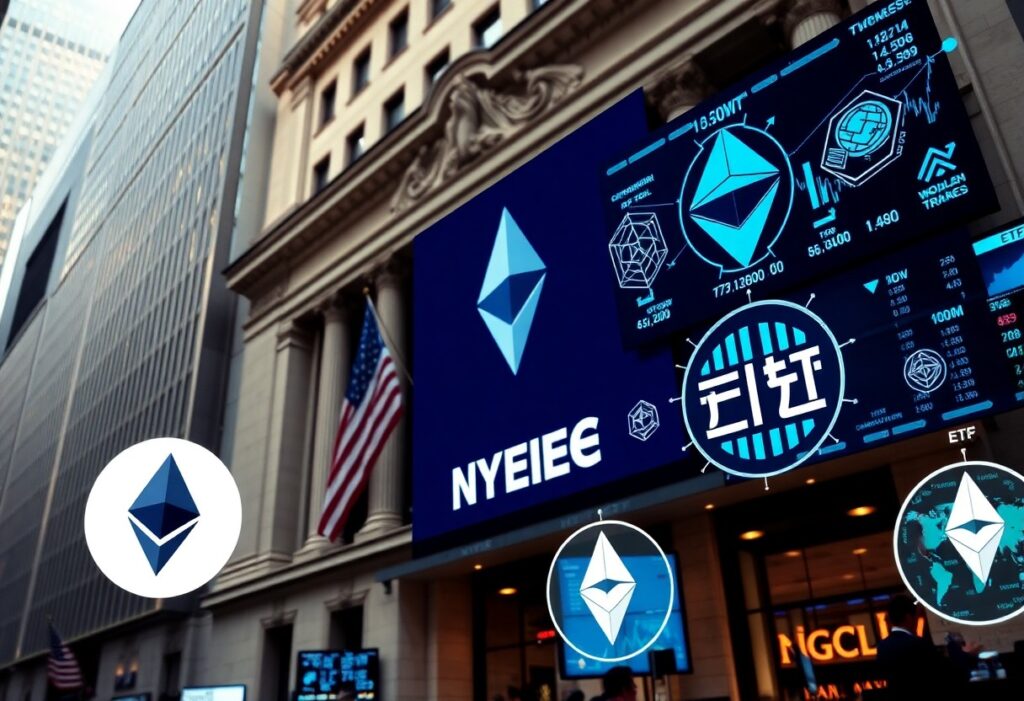Now Reading: Ethereum Staking Participation Declines from November 2024 Peak
-
01
Ethereum Staking Participation Declines from November 2024 Peak
Ethereum Staking Participation Declines from November 2024 Peak

Just as you explore investment opportunities in the Ethereum network, it’s vital to note that staking participation has significantly declined since its peak in November 2024. As you investigate the world of Ethereum, understanding this trend can impact your returns and influence your staking strategies. The reasons behind this drop can range from market sentiments to technological developments, which may reshape your perspective on participating in Ethereum staking. Stay informed to navigate this evolving landscape effectively.
Key Takeaways:
- Ethereum staking participation saw a significant peak in November 2024, driven by increased interest and investment in the Ethereum network.
- Following this peak, a noticeable decline in staking participation indicates potential shifts in investor confidence and market conditions affecting the ecosystem.
- Factors contributing to this decline may include changes in Ethereum’s network performance, competition from other staking platforms, and evolving investor strategies.
Ethereum Staking Overview
While Ethereum staking has gained popularity since its proof-of-stake transition, participation has seen fluctuations. At its peak in November 2024, many users eagerly staked their ether, but recent trends indicate a decline. Understanding the mechanics of staking and its implications for the Ethereum ecosystem is important for anyone looking to engage with this innovative blockchain technology.
How Ethereum Staking Works
Overview: Ethereum staking allows you to contribute to the network’s security and operations by locking up your ether. In return, you earn rewards for validating transactions through a process known as “forging” or “proposing blocks.” The more ether you stake, the higher your chances of being selected as a validator, which helps secure the network while providing you with passive income.
Importance of Staking for Network Security
Staking plays a vital role in maintaining the security of the Ethereum network. When you participate in staking, you are actively engaging in the consensus mechanism that maintains the integrity of transactions. Your staked ether serves as collateral; if you act maliciously, you risk losing your investment. This incentivizes honest behavior among validators, ultimately enhancing the entire network’s stability.
Another critical aspect to consider is that a robust staking community ensures the decentralization of the network. When more users participate in staking, it becomes increasingly difficult for any single entity to dominate, thereby reducing the risk of centralized control. This diversity not only strengthens security but also enhances the resilience of the Ethereum platform against potential attacks, making it safer for all users involved.
Peak Staking Participation in November 2024
The peak of Ethereum staking participation occurred in November 2024, reaching unprecedented highs that signaled strong confidence in the network. This surge was short-lived, as recent reports reveal a decline, with the Ethereum Staking Rate Plummets to July 2024 Levels. Enthusiasts were initially drawn to the potential for substantial rewards, leading to an influx of staking participants.
Factors Driving the November 2024 Surge
For many, the November 2024 surge was driven by key factors that swayed investor behavior:
- High staking rewards
- Market optimism
- Network upgrades
- Increased adoption
Knowing that such positive trends fostered community engagement, you may have seen a spike in participation as Ethereum’s potential appeared limitless.
Market Conditions and Staking Incentives
The market conditions in late 2024 played a significant role in staking participation. Investors were keen on capitalizing on favorable market dynamics and attractive staking incentives. The combination of promising price trends and enhanced rewards systems created an alluring environment for both new and seasoned stakers.
Driving the enthusiasm further, you witnessed the impact of evolving macroeconomic factors. A favorable regulatory landscape and high-profile endorsements contributed to an air of confidence, while high staking rewards compelled you to lock your assets for longer periods. However, you should consider that volatility may arise, and understanding the interplay between these market conditions and staking incentives remains necessary for making informed decisions about your investments.
Decline in Staking Participation
Once again, the Ethereum network experiences a downturn, as Ethereum Staking Ratio Plummets to 27% Amid Market Shifts demonstrates a significant decline from its November 2024 peak. Investors may be reconsidering their strategies as the overall outlook for staking diminishes, leading to a marked decrease in active participants. This shift prompts a closer examination of the underlying factors influencing this trend.
Key Reasons for the Decrease
Above all, external economic conditions, fluctuating market sentiments, and increased competition from other blockchain projects have contributed to the decline in Ethereum staking participation. These factors have likely made investors cautious and less willing to commit their assets long-term.
Impact on Ethereum Network
For the Ethereum network, declining staking participation can have significant consequences for its overall stability and security. Lower participation rates may lead to reduced incentives for validators, which can ultimately impact transaction processing times and network performance.
Understanding the full scope of this impact is important for you as a participant in the Ethereum ecosystem. A decrease in staking participation can weaken the network’s security, increase the risk of centralization, and hinder Ethereum’s overall scalability. It is vital to keep an eye on these developments to make informed decisions about your investments and strategies within the blockchain landscape.
Investor Sentiment and Market Reactions
Despite the sharp decline in Ethereum staking participation since its peak in November 2024, investor sentiment remains mixed. Many in the crypto community are grappling with feelings of uncertainty, as fluctuating market conditions and external economic factors have led to skepticism regarding the long-term viability of staking. This volatile environment has also prompted market reactions that further reflect the hesitance of potential participants to engage with Ethereum’s staking ecosystem.
Reactions from Stakers and Validators
One notable reaction from stakers and validators has been an increasing concern regarding their long-term commitment. Several have expressed doubts about the profitability of their investments and are reevaluating their strategies amid changing regulations and decreased rewards. This introspection has led some to consider diversifying their portfolios or even stepping back from staking altogether.
Broader Crypto Market Implications
Implications of the declining Ethereum staking rates extend beyond just individual investors, affecting the overall crypto market landscape. A significant drop in staking participation may lead to reduced network security and influence Ethereum’s price stability, making it more vulnerable to market shocks. Furthermore, if this trend continues, it could raise concerns among institutional investors, locking in a negative feedback loop that stifles innovation and adoption. As you navigate these changes, it’s crucial to stay informed about market dynamics and potential shifts in investor behavior.
Broader trends caused by the decline in Ethereum staking can lead to increased volatility in the cryptocurrency market. If this trend persists, it could bolster fears surrounding Ethereum’s sustainability, urging investors to rethink their strategies. Additionally, reduced validator participation may diminish the overall health of the Ethereum network, raising alarms about security and performance. As you keep an eye on these developments, consider how they might impact your investment choices and the future of the crypto ecosystem.
Future Outlook for Ethereum Staking
Your engagement with Ethereum staking may be tested in the coming period as the market adapts to new dynamics. As Ethereum staking sees notable pullback as market shifts…, staying informed about future trends and developments will be important for your investment decisions.
Potential Recovery Scenarios
Any signs of recovery in Ethereum staking participation will likely depend on market sentiment and external factors influencing investor behavior. Monitoring key indicators can help you identify potential upswings.
Challenges and Opportunities Ahead
Ahead of you lies a landscape filled with both risks and rewards in Ethereum staking. Understanding these dynamics can empower you to navigate the changing tides effectively.
This market will present you with significant challenges such as regulatory changes and fluctuating confidence among investors, potentially impacting your staking decisions. However, there are opportunities for growth, especially if Ethereum evolves and enhances its network efficiency and scalability. Staying proactive can enable you to leverage emerging trends, ensuring your position within the staking ecosystem remains tenable and rewarding.
Conclusion
The decline in Ethereum staking participation since its peak in November 2024 indicates shifting dynamics in the blockchain ecosystem. As you navigate this landscape, staying informed about factors influencing staking rewards and network changes can help you make informed decisions about your investments and participation in Ethereum staking opportunities. Understanding these trends may enhance your strategy moving forward, ensuring that you remain engaged with the evolving cryptocurrency environment.
FAQ
Q: What factors contributed to the decline in Ethereum staking participation after the peak in November 2024?
A: Several factors influenced the decline in Ethereum staking participation. Firstly, changes in staking rewards have made it less attractive for some investors to lock their assets in the Ethereum 2.0 network. A decrease in the rewards offered, coupled with increased network fees, can deter users from participating. Secondly, market volatility and the overall performance of Ethereum have prompted some stakeholders to withdraw their staked assets to take advantage of price fluctuations. Finally, external regulations and market conditions may have also played a role, leading to increased caution among participants regarding long-term commitments in staking.
Q: How has the decline in staking participation affected the Ethereum network?
A: The decline in staking participation can have several implications for the Ethereum network. A reduced number of stakers may lead to lower overall network security, as fewer validators contribute to block production and transaction validation. This could potentially result in slower transaction times and increased risk of centralization, as a smaller pool of validators holds a significant proportion of the staked ETH. Additionally, a decrease in participation may impact the governance of the network, as stakers typically play an important role in decision-making processes affecting future upgrades and protocol changes.
Q: What strategies can be employed to improve Ethereum staking participation moving forward?
A: To enhance Ethereum staking participation, several strategies can be explored. One approach is to re-evaluate and possibly increase staking rewards to attract new participants and retain existing ones. Educating potential stakers about the benefits of staking versus trading can also help foster greater involvement. Additionally, improving user-friendly interfaces and platforms for staking can simplify the process and encourage wider participation. Lastly, fostering community initiatives and incentivizing smaller investors may help create a more inclusive and engaged staking environment.























